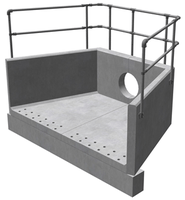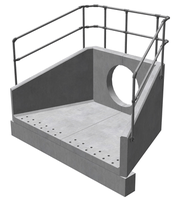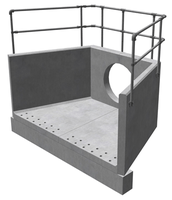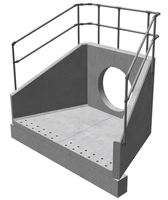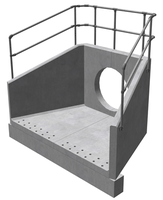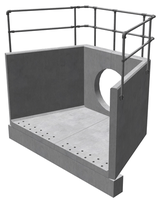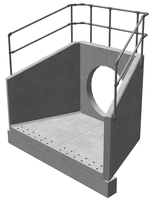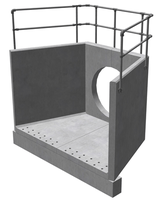Both wingwalls project at 90 degrees from the backwall. This design is common for Severn Trent Water specifications
Select the internal diameter of the pipework being used with your headwall. The opening in the headwall will be cast to suit the outside diameter of the specified pipe material and diameter
Choose the material of the pipework you will be using with the headwall. The opening in the headwall will be cast to suit the outside diameter of the specified pipe material and diameter
Althon Sewers for Adoption precast headwalls should be used when a concrete headwall is part of a Section 104 Agreement and the sewers are to be adopted once completed by the local Water Company. The materials used and installation must comply with the ‘Sewers for Adoption’ guidelines
Select whether or not your require handrails factory fitted to your headwall. Various arrangements such as Kee Klamp Handrail ® to 3 sides of the headwall or to the backwall only are available
Select whether you will require a grating on your headwall. If you wish to have a penstock or a flap valve fitted please select a Cranked Grating
Sewers for Adoption Compliant headwalls for pipework over 350mm should be fitted with a SFA Type 1 Outfall Safety Grille
Select if you would like an appropriately sized flap valve fitted on your headwall.
Flap valves prevent water backing up the discharging pipework during storm events and periods of flooding
If you require a grating as well please select a Cranked Grating
Select if you would like an appropriately sized penstock fitted on your headwall.
Penstocks are used to isolate the flow of water and manage water levels
If you require a grating as well please select a Cranked Grating
Backwall heights
This is the overall height of the backwall of the headwall. Headwalls within a specific range often have a variety of backwall heights available.
Backwall height should be a consideration when considering cover to invert levels or the profile of the surrounding area or slope of the bank.
We are able to cast the invert level of the opening into the backwall of our precast headwalls to a specified level.
Single or multiple pipe openings
We cast the openings in our precast headwalls to suit the specified pipe diameter and material and if required to a specified invert level.
We are also able to accommodate multiple pipe openings in our headwalls. These openings can be arranged anywhere on the backwall of the headwall.
Where required we are also able to cast openings for pipework through the wingwalls (side walls) of our precast headwalls
Specifiable pipe invert levels
Typically we cast the pipe openings in our standard precast headwalls at a 100 – 150mm invert level up from the spillway of the headwall.
Sewers for Adoption compliant precast headwalls should have the invert level of the pipe opening set 225mm above the spillway.
When requested we can set the invert level of the pipe opening wherever on the backwall of the headwall you require.
We cast the openings in our precast headwalls to suit the specified pipe diameter and material and are also able to accommodate multiple pipe openings in our headwalls
Maximum pipe size
This refers to the largest single opening we are able to accommodate in any given headwall.
The diameter opening relates to the internal diameter of any given pipework.
We will cast the opening into our headwalls slightly larger than the outer diameter of the specified pipework to make installation on site as easy, fast and safe as possible.
Sewers for Adoption Compliant headwalls for pipework over 350mm should be fitted with a SFA Type 1 Outfall Safety Grille
Our Sewers for Adoption compliant outfall safety grilles are hinged with a padlock facility. On SFA compliant grating should be 270mm wider than the pipe OD
As Revit geometry (simple solid) to a Revit Family (.RFA)
As an Autodesk Exchange File (.ADSK)
Material of your orifice plate (galvanised steel, grade 304 stainless steel or grade 316 stainless steel)
The diameter of the pipework the orifice plate is to cover
Choose the diameter of the manhole being used for a curved orifice plate, or choose flat plate for orifice plates being fixed to flat surfaces such as a headwall
Internal Box Culvert Dimensions (width x height)
You can specify the height of the pipe opening above the spillway (base or apron) of the headwall if required
Thickness of toe extension (from left to right in section)
Both wingwalls project out from the backwall at the same angle
Left hand wingwall (as you face the headwall) projects further than the other wingwall, creating an angle on the spillway. This is the Environment Agency’s preferred method for headwalls discharging into rivers
Right hand wingwall (as you face the headwall) projects further than the other wingwall, creating an angle on the spillway. This is the Environment Agency’s preferred method for headwalls discharging into rivers
Depth (or height) of toe extension (from top to bottom in section)
Fitted penstock valves for the control and isolation of water
Please provide pipe material (if known) for example concrete, clay, twinwall plastic
As an Industry Foundation Classes (.IFC) file. Inventor provides IFC2x3 output
SFA Type 3 outfall safety grille design is exactly as Figure C.6 of the Sewers for Adoption Guidelines and Figure 10 of Sewers for Scotland except the grate finishes 150mm above the invert level of the incoming pipe allowing low flows to run uninterrupted without compromising safety
SFA Type 4 outfall safety grille is hinged on both sides, has a padlock facility at the top and bottom and bars spaced at 100mm. Type 4 outfall safety grilles are particularly useful where space on the spillway of a headwall or outfall structure is restricted either due to length or if there is a requirement for stepped baffle blocks etc.
Type 5 outfall grilles are Networks Outfall Grilles specified for use on headwalls and outfalls to be adopted by United Utilities Plc their Standard Detail STND/00/007 refers.
Cranked gratings are useful for when you have a flow control device such as a penstock or flap valve fitted to the headwall
Kee Klamp handrail to backwall and both wingwalls of the headwall
A V notch weir is a physical barrier significantly higher than the water level except for a specific V notch cut into the precast panel on the spillway of the headwall
Our standard grating to prevent access to connecting pipework
Hinged version of our standard grating to prevent access to connecting pipework
Water Cushions on outlet headwalls form a silt trap and on an inlet headwall are a means of reducing the velocity of the flowing water
Fitted flap valve to prevent backflow during storm events and flooding
Cascade panels slow down the flow of water discharging from the pipe across the spillway of the headwall before entering the watercourse
Stop logs on headwalls allow for the isolation and control of water and are a means to control water levels
Inline non return valve to prevent backflow up the connecting pipework
Handstop gates are design to isolate and control the flow of water discharging from pipes or to manage water levels
Sewers for Adoption compliant hinged & lockable outfall safety grille
Sloped gratings are useful as they can be raked of debris in areas where it is likely to build up
Allows access onto the grating above the headwall for maintenance of the headwall and clearance of trash and debris
Hinged and lockable, useful for when there is no space on the backwall of the headwall but a grating is still required
Framed 25 x 25mm mesh grating to prevent rodents and other wildlife entering the pipework
Kee Klamp handrail to backwall only of the headwall
Kee Klamp handrail to backwall and halfway down both wingwalls of the headwall
Estate (black) handrail to 3 sides of headwall for aesthetically sensitive areas
Pedestrian type guardrail to backwall and both wingwalls of the headwall
Kee Klamp handrail to backwall and both wingwalls of the headwall with mesh infill to prevent access
Ladder with gate access and walk through to backwall of precast headwall
Ladder with gate access and walkthrough to sidewall of precast headwall
Precast concrete steps with handrails down spillway of the headwall
Fitted pond liner brackets to fix pond liner directly to the precast headwall
Stainless steel dovetail slots cast into the headwall to tie in brick, stone or other cladding materials
Stabilisation tool for tall headwalls with short spillways (H40 type headwalls only)
Animal / Mammal Shelf
Precast concrete mammal ledge for safe passage of the animal down or up the spillway of the headwall to or from the culvert
SFA Type 2 outfall safety grille is hinged on both sides, has a padlock facility at the top and bottom and bars spaced at 100mm. Type 2 outfall safety grilles are particularly useful where space on the spillway of a headwall or outfall structure is restricted either due to length or if there is a requirement for stepped baffle blocks etc
Orifice plates restrict and regulate the flow of water.
Fitted Duckbill valves prevent backflow during storm events and flooding
Dissipation blocks slow down the flow of water discharging from the pipe across the spillway of the headwall before entering the watercourse
Baffle blocks slow down the flow of water discharging from the pipe across the spillway of the headwall before entering the watercourse
- Splayed : Most precast headwalls and Sewers for Adoption compliant headwalls have splayed wingwalls. Our standard range of headwalls all have splayed wingwalls.
- Rectangular : Our rectangular (RSFA) precast headwalls have been designed to comply with Severn Trent Water specifications for concrete outfalls. Althon rectangular headwalls are also Sewers for Adoption compliant and are available with wall profiles to suit bank gradients of 1 : 1, 1 : 2 and 1 : 3
- Right & Left Hand Angled : The Environment Agency’s preferred headwall outfall construction type for pipework discharging into a main river. Angled precast headwalls allow pipework entering a watercourse at an angle to be accommodated or for an outfall to be situated on a bend in a river

